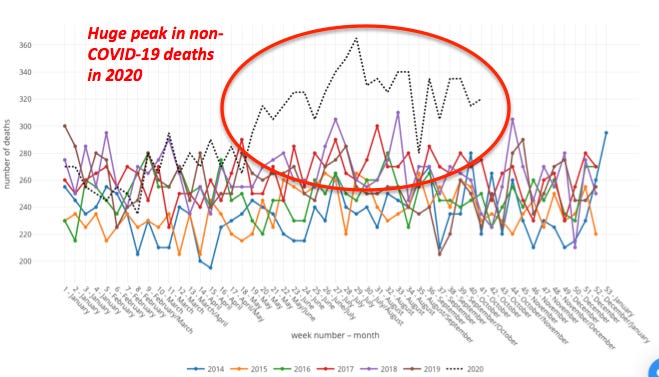Statistics Canada Mortality Data Raises Question Whether COVID or Lockdowns Caused Deaths in Younger Age Cohorts in 2020
Chapter #5 - The Corona Virus Chronicles - Questions that need answers
I wrote this piece in January of 2021, after studying and analyzing a combination of Health Canada’s and Statistics Canada’s mortality rate charts for the years 2014 through to 2020, and came up with surprising results.
No doubt, we all bid an unfond farewell to the year 2020 in COVID with a glass of champagne in solitary confinement, as per the orders of our government overlords. As we put the notorious 2020 behind us–a year of lockdowns, travel bans and restrictions, mask mandates, stay-at-home orders, school closures, church closures, and holiday cancellations–we can hope 2021 will be better. Yet as we listen to the talking heads on television soberly giving us the daily death counts and raising more alarms of growing case numbers, just to ensure we understood the need for the lockdowns and why we may need more, it gives me pause to wonder if 2021 will actually be better. But, while listening to the death counts, it also made me wonder, what else killed people in 2020, besides COVID, so I decided to see what I could find about that.
While the general assumption may be that, if the 2020 death rate exceeded that of previous years, then COVID-19 would account for those increased numbers. That assumption, when you take deaths of the very elderly out of the equation, is tenuous at best. The following illustrations are Statistics Canada's colour coded charts which tracked annual death rates (all causes) in Canada, for the years 2014 to 2020. The rates are calculated on a weekly basis, starting on a Sunday and ending on the following Saturday. Rates are tracked by the following age groups:
Age 44 years and under
Age 45 to 65 years
Age 65 to 84
Age 85 and over
Death Rate—All Age Groups
Weekly Death Counts – All Age Groups
This first chart (above) tracking weekly deaths in 2020, for all age groups (black dotted line), clearly demonstrates that a vast number of Canadians died in the spring and early summer of that year. Given that was the first wave of the pandemic it is likely that many people succumbed to COVID. That, however, is all it tells us.
Death Rate—85 plus
The second chart, which tracks the deaths of those aged 85 plus, shows a similar peak during the same time frame for 2020, clearly indicating that COVID-19 hit this age cohort very hard. Actually current estimates are that the majority of the COVID-19 deaths in Canada for the year 2020, occurred in people aged 86 and over. It should be further noted that the majority of those deaths, estimated to be as high as 70 percent, occurred in residents of long term care facilities (LTCF) in the first wave of the pandemic, when the entire country was in lockdown. The same thing has happened again in the second wave (so much for lessons learned).
Death Rate—Under Age 44
It is not surprising that old people account for a large number of deaths in any given year, even without COVID-19 in the mix. People get old and they die. It is, however, unusual to see a rise in the deaths of younger people, given that we already know the majority of them do not get very ill if they contract the virus. Yet, when looking at the death statistics charted by Statistics Canada for people under the age 44, we see a distinctive spike in the death rates in 2020, compared to previous years. There is a huge surge in deaths beginning in May and carrying on through to mid-October, where the data for 2020 ends, much higher than any of the previous years tracked. A total of 1880 more deaths occurred in this age group in 2020, compared to the same period in 2019. Yet, Health Canada records indicate that, as of the end of 2020, only 144 people under the age of 49 have succumbed to COVID, since the pandemic began, and all had comorbidities.
So, what accounts for this alarming rise in the death toll for this age group in 2020, if it wasn’t COVID? Does the answer lie in the fact that a large chunk of this group, particularly those between the ages of 20 and 44, were people who were most impacted by the shutdowns and lockdowns. This includes university students forced to complete their studies on-line and isolated from their peers, or to simply withdraw from school, in the hopes that in-person classes will return the following semester. What about young people working in the service industry losing steady incomes and on-the-job experience, young entrepreneurs losing opportunities, graduates moving into a job market that offers few career opportunities, when businesses are shut down, or the business owners who were just one more lockdown away from losing their livelihoods. What about recovering drug addicts who had life saving AA and NA meetings shut down. What about young families trying to keep their heads above water as they try to balance work (if they have it) and caring for kids that are doing remote-learning from home. Do you think maybe the stress and uncertainty for any of them might have been more than some of them could take.
The leading causes of death for this age cohort, in 2019 and previous years, cited by Statistics Canada, are suicides (self harm) and accidental (unintentional injuries which include drug overdoses). Could this account for the big jump in deaths in this group for 2020. Yet, unless someone is curious enough to look at this data, which is readily available online, who would know about this sharp rise in deaths in young people. We certainly don’t hear much about this from our governments and the legacy media (why aren’t they asking questions about this, or have they bothered to look at the statistics?), when they announce further restrictions and draconian enforcement measures.
Death Rate—Ages 44 to 65
The chart tracking deaths in the age group 44 to 65, again illustrates some significant spikes in death rates in this age cohort in 2020. It does, however, reveal similar significant spikes in other years. Another notable aspect is that some of the weeks during which there were spikes in deaths in 2020, there were also weeks where deaths diminished considerably.
In fact, according to data provided to Worldometer* by Statistics Canada, COVID deaths dropped from an average high of over 100 deaths per day in the spring and early summer of 2020, to an average of ten or less per day, over the rest of the summer and early fall. This would lead one to conclude that the spikes in deaths in the 44-65 age group, in that same time period, as illustrated in the Statistics Canada chart, were not all due to COVID-19.
*Worldometer, is a reference website that provides real-time statistics for diverse topics. It is owned and operated by data company Dadax.
Death Rate – 65 to 84
Again, in this age group you can see spikes in deaths when COVID peaked during the first wave. That is to be expected, because again, people over the age of 75 account for a total of 75 percent of COVID deaths (again the majority in LTCFs) in Canada. As well, the charting for this age group also reveals that while 2020 death rates were higher than in previous years, in general, they remained so, even during the summer and early fall when COVID cases dropped dramatically. So again, what accounts for the rise in deaths, when it can’t be COVID? Could it be delayed diagnostic tests or treatments for serious diseases such as cancer? Could it be the postponement of medical procedures such as pacemaker implants, biopsies, and other elective surgeries to treat serious health issues? This, all in the name of clearing the hospitals for COVID cases that didn’t arrive during the first wave.
Summarizing
So it would appear that COVID-19 certainly increased death rates in the very elderly and particularly those in LTCFs in 2020. When looking at other age groups, however, it would appear that it accounts for some, but certainly not all increases in death rates for 2020. Most troubling of this is the dramatic increase in non-COVID deaths in those under that age of 44, yet this does not seem to be on either governments’ or the legacy media’s radar when they call for more lockdowns.








